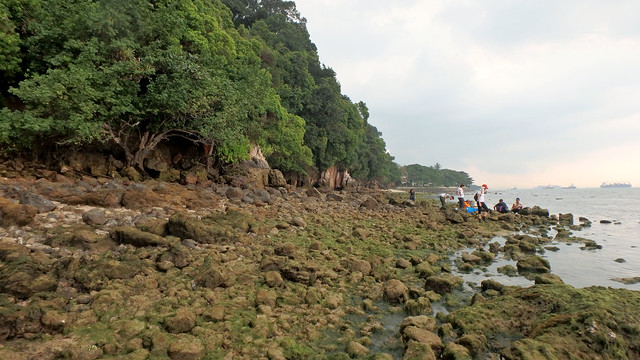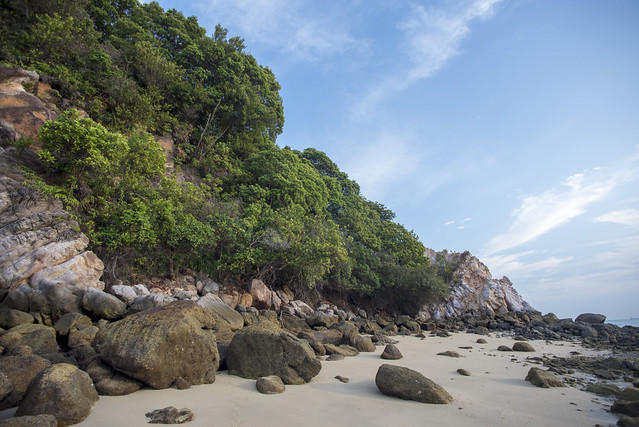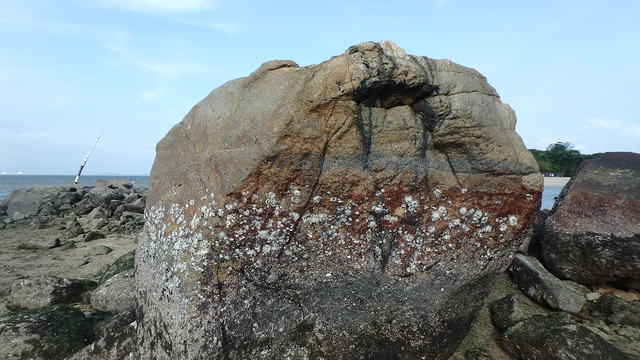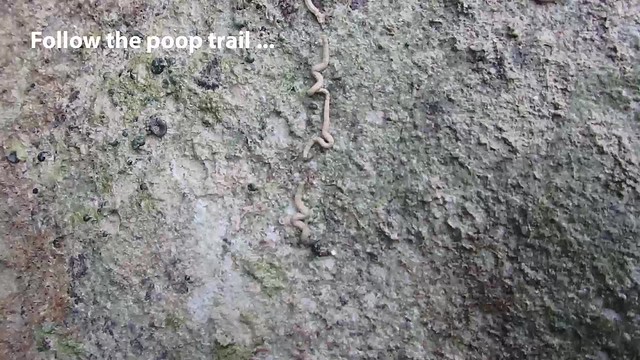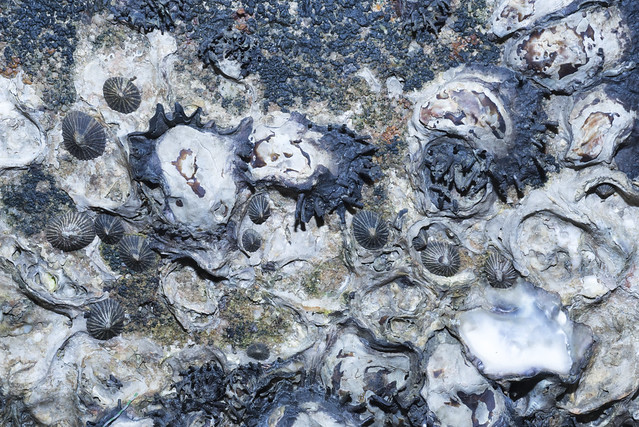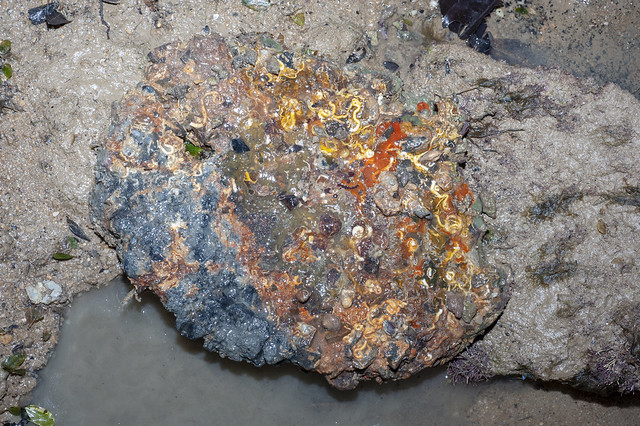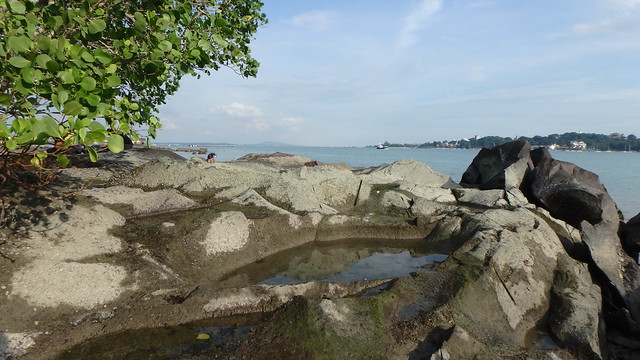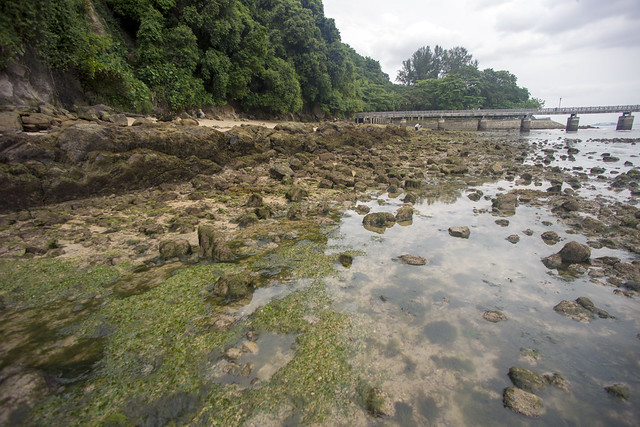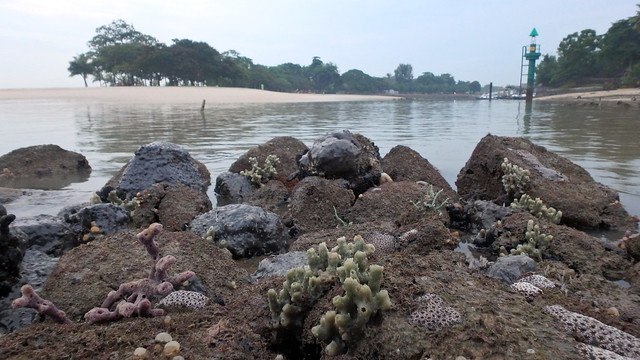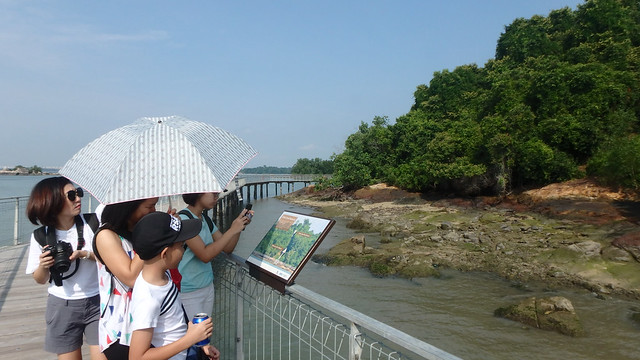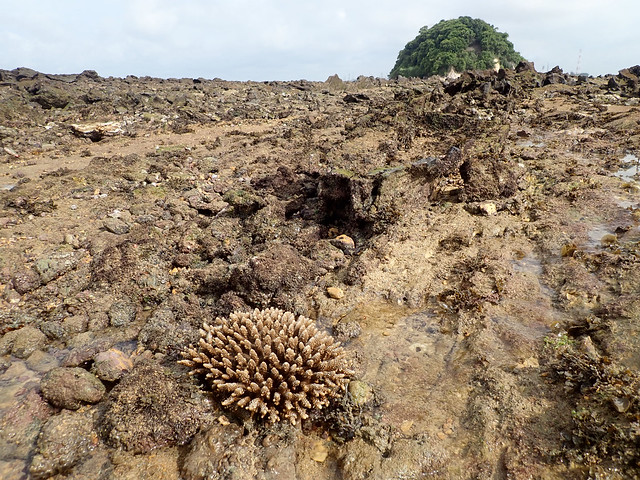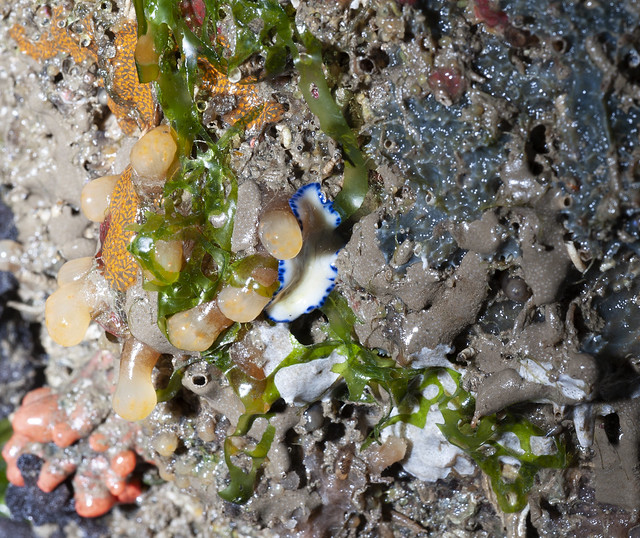Here's more about our rock dwellers and where you might find them.
Home on the Rock: A shore with lots of boulders, rocks and stones is called a rocky shore (surprise!). Such shores are often found at the base of natural cliffs which are cloaked in a coastal forest. The rocky shore is a result of the natural, gradual erosion of such cliffs. Rocks provide a firm surface, a scarce commodity in the sea. Rock dwellers also benefit from nutrients flowing down from coastal forests.
Rock dwellers, especially those living at or near the high water mark, have to cope with being baked in the sun at low tide, while waves may pound on them at high tide. When it rains, they have to cope with sudden changes in salinity.
Where are the animals? At low tide during daylight, most rock dwellers are inactive. Some seal themselves up in their shells. Others hide in cool wet crevices, under stones or are buried in the sand nearby. At night or on a cool, overcast day, you might see some of the more active snails, slugs, crabs and sea slaters out and about. But they are often well camouflaged.
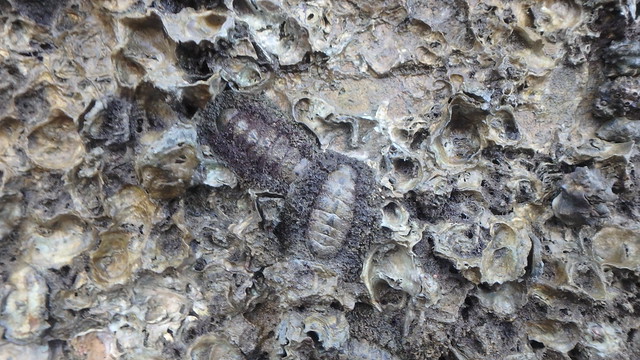 |
| These fuzzy animals are Chitons, a kind of snail! |
Although a rock may appear to be barren, often it is coated in a thin layer of tiny seaweeds or a film of microscopic plants. Grazing on this meadow are tiny animals.
Many rock dwellers have hard shells. Barnacles are common on all hard surfaces immersed in the sea. Often mistaken for snails because of their hard 'shells', barnacles as actually crustaceans. The larvae of barnacles are shrimp-like and swim freely. As it develops, the larvae eventually glues itself head down onto a hard surface and develops hard shell with an opening in the centre. At low tide, the opening is sealed by a door (operculum) made up of a pair of plates. At high tide, the delicate 'feet' of the animal emerges to gather food particles from the water.
 |
| Clockwise from top left: Acorn barnacle closed, Acorn barnacle extending its 'feet' when submerged, Volcano barnacle, Star barnacle. |
Limpets are snails with a large foot. Unlike the immobile barnacles, limpets can move around. Like most other snails, limpets have tentacles, a broad foot and a rough tongue to graze on the film of tiny seaweed that grows on the rocks. The limpet's broad foot firmly grips the rock to avoid being dislodged by waves or predators. Their grip is so strong that if you try to pry them off, you will hurt them. So please don't do this. If you want to see what the limpet looks like under its shell, here's some photos.
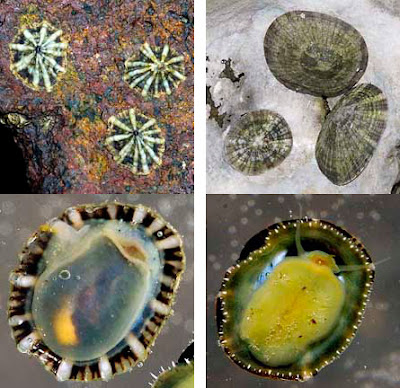 |
| Javan false limpet (left) and Smooth limpet (right). |
 |
| Star limpet (left) and Guam false limpet (right). |
The fiercest predators on the rocky shore are crabs. Rocky shore crabs often have strong claws equipped with special pincers to deal with rock dwellers. Usually one large claw to crush shells, scrape off clinging animals. The other claw often has tinier pincers like chopsticks to dig out the prey from the crushed shell.
 |
| Clockwise from top left: Ferocious reef crab, Spotted-belly forceps crab, Maroon stone crab, Stone crab. |
There are other smaller crabs and crustaceans scuttling around the rocks. Scavenging on dead animals or eating the growths on the rocks.
 |
| Clockwise from top left: Sea slater, Purple climber crab, Rafting crab, Sally-light-foot crab. |
Snails are with sturdy shells that can survive crabs are commonly seen on our rocky shores, like these Turban snails. The 'door' (operculum) that seals their shell opening is smooth and hemi-spherical (rounded) on the side facing outwards. This possibly makes it difficult for crabs to get a grip and pry out the snail. The shape and markings of the operculum makes it look like a cat's eye so that is what it is sometimes called.
 |
| Top row: Ribbed turban snail Lower row from left: Dwarf turban snail and Spurred turban snail. |
Although similar in shape, the Top shell snails have an operculum that is thin and flexible. This allows the snail to withdraw deep into the coils of the shell, hopefully out of the reach of crab pincers.
 |
| Top row: Toothed top shell snail. Lower row from left: Spotted top shell snail and Giant top shell snail. |
Bouncing escape! When alarmed, Nerite snails can immediately unclamp from a rock, and retract into their hard round shells. Whereupon, they bounce down the rocks like marbles. This is probably how these slow snails can rapidly escape from crabs and other predators.
 |
| Clockwise from top left: Polished nerites, Scaly nerite, Ox-tongue nerite, Waved nerite. |
Rocky nursery: Hard surfaces are a great place to lay eggs on! The distinctive egg capsules of snails are commonly seen. Like these Drills which lay masses of bright yellow egg capsules. Each egg capsule may contain 20-40 eggs. The egg capsules turn purple when the free-swimming larvae hatch. Many drills secrete a colourless mucus that turns purplish when exposed to air. This secretion is a neurotoxin that paralyses or kills other sea creatures.
The Spiral melongena also lays distinctive egg capsules, usually in the lower areas of a rocky shore.
Zones of life: Life settles in obvious layers on the rocky shore near the high water mark. As each kind of plant or animal settles and thrives in a spot it is best adapted to, distinct zones (zonation) on a rock often develop in response to tidal and other influences.
Down where it's wetter: The areas lower down are more often covered in water so tough tiny sea anemones can sometimes be found. Often in cool crevices or rock pools, and among damp areas created by barnacles and oysters.
 |
| Clockwise from top left: Banded bead anemones out of water, Banded bead anemones in water, Pink bead anemone, Lined bead anemone. |
Some safety tips for rocky shores
Watch your step! Many rock-dwellers are well camouflaged. Onch slugs often perfectly match the rock surface.
Don't pick snails off the rock! Many snails, like these periwinkle snails, glue their shells to the rock then retract completely into their shells at low tide. If you pick off the snail from the rock, you can't 'stick' them back onto the rock. When the tide comes in, the snails may be washed away and die.
 |
| Clockwise from top left: Knobbly periwinkles, Round periwinkles, various Rock periwinkles. |
Please don't pry open oysters or barnacles. You will hurt and kill them.
Life on the Dark Side: Rocks that are usually submerged have lots of life under them. You can have a look at them only during the narrow window of low spring tide. Under a stone it is safe, cool and wet and many animals grow and hide there. On the upper side, large seaweeds and immobile lifeforms that need sunlight may grow. Please be gentle when looking under a stone. Be sure to put it back exactly the way you found it so that animals and plants are not harmed. Don't crush animals as you turn the stone over.
Pool party: Sometimes, a pool of water may be trapped in a large boulder or arrangement of rocks. Such a rock pool is precious shelter for a wider range of animals during low tide. Don't climb rocks! The rocks are slippery with algae and covered with razor sharp barnacles that can give a nasty cut.
Where can we explore rocky shores in Singapore?
Labrador has the last large mainland rocky shore.
There are also narrow and patchy rocky shores at Changi.
Among our northern islands, there are rocky shores on Pulau Ubin, the most famous being the one at Chek Jawa.
While on our Southern islands, there are rocky shores at Sentosa, St. John's Island and the two Sisters Islands.
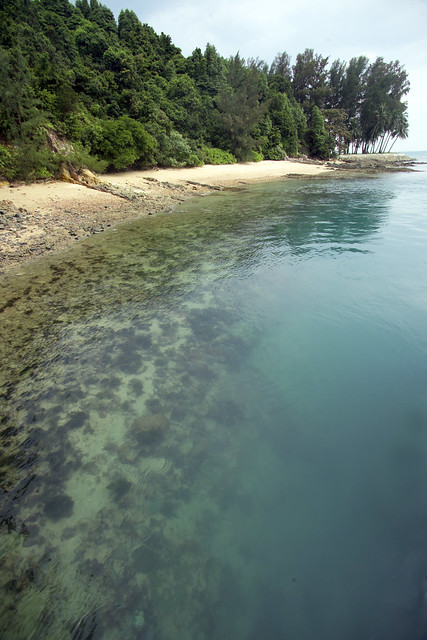 |
| Coastal forest and rocky shore with reef edge at Big Sisters Island. |
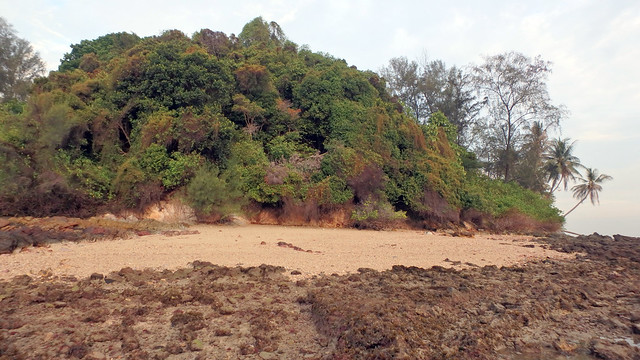 |
| Coastal forest and rocky shore at Small Sisters Island. |
Pulau Jong, our last untouched island, has the full spectrum of coastal forest, rocky shore and reefs.
Even artificial surfaces such as seawalls, jetty legs and large trash on the shore provide hard surfaces for dwellers adapted to a rocky shore. While some rocky shore animals can live on artificial sea walls, there is a greater diversity of plants and animals on a natural rocky shore. In some sandy areas, a hard surface may become a miniature rocky shore.
How can I see these rocky shores for myself?
Here's upcoming walks to some of these rocky shores
- 14 Aug (Tue): Sentosa intertidal guided walk
- 19 Aug (Sun): Free Chek Jawa boardwalk tour with the Naked Hermit Crabs
Check out more upcoming seashore activities on wildsingapore happenings.
This article is written for Celebrating Singapore Shores as part of International Year of the Reef 2018.

